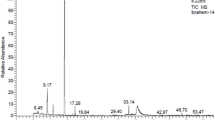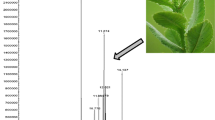Abstract
The recent outbreaks of mosquito-borne diseases highlighted the pivotal importance of mosquito vector control in tropical areas worldwide. Several strategies have been developed to control vector populations and disease transmission in endemic areas. The steps to obtain natural active compounds involve the pre-selection in a biological model and subsequently evaluation on specific models. The present study reports the evaluation of 35 extracts, fractions, and essential oils obtained from five species from the Annonaceae family on Artemia salina and Culex quinquefasciatus. The A. salina results were used as a pre-screening for larvicidal test about mosquitoes. A correlation of biological activity in both bioassays was observed for the hydroethanolic extracts and their respective hexane and chloroform fractions of the leaves of Annona species, except A. nutans. The same correlation was also observed for all tested essential oils and petroleum ether extracts from Duguetia species. It was possible to limit an interval of lethality about A. salina, which has a corresponding range to the larvicidal test against the mosquito. The main components present in D. lanceolata essential oil or enriched fraction were α-selinene, aristolochene, (E)-caryophyllene, and (E)-calamenene. For D. furfuracea, the main components present of the underground parts were (E)-asarone, 2,4,5-trimethoxystyrene, spathulenol, and bicyclogermacrene for aerial parts. The A. salina test could be used as a model for the pre-screening of larvicidal activity.
Similar content being viewed by others
References
Adams RP (2017) Identification of essential oil components by gas chromatography/mass spectroscopy. Electronic version of 4th ed. Allur Publish Corpor, Illinois
Ahammadsahib KI, Hollingworth RM, JP MG, Hui YH, JL ML (1993) Mode of action of bullatacin: a potent antitumor and pesticidal Annonaceous Acetogenin. Life Sci 53(14):1113–1120
Andrade-Ochoa S, Sánchez-Aldana D, Chacón-Vargas KF, Rivera-Chavira BE, Sánchez-Torres LE, Camacho AD, Nogueda-Torres B, Nevárez-Moorillón GV (2018) Oviposition deterrent and larvicidal and pupaecidal activity of seven essential oils and their major components against Culex quinquefasciatus Say (Diptera: Culicidae): synergism–antagonism effects. Insects 9(1):25
Asakawa Y, Ludwiczuk A, Nagashima F (2013) Phytochemical and biological studies of bryophytes. Phytochem 91:52–80
Attar N (2016) Zika virus circulates in new regions. Nat Rev Microbiol 14:62
Barbosa TP, Junior CG, Silva FP, Lopes HM, Figueiredo LR, Sousa SC, Batista GN, Silva TG, Silva TNS, Oliveira MR, Vasconcellos MLAA (2009) Improved synthesis of seven aromatic Baylis–Hillman adducts (BHA): evaluation against Artemia salina Leach. and Leishmania chagasi. Eur J Med Chem 44(4):1726–1730
Benelli G (2015) Research in mosquito control: current challenges for a brighter future. Parasitol Res 114(8):2801–2805
Benelli G (2016) Plant-mediated biosynthesis of nanoparticles as an emerging tool against mosquitoes of medical and veterinary importance: a review. Parasitol Res 115(1):23–34
Benelli G (2017) Commentary: data analysis in bionanosciense – issues to watch for. J Clust Sci 28:11–14
Benelli G (2018) Plant-borne compounds and nanoparticles: challenges for medicine, parasitology and entomology – GREEN-NANO-PEST&DRUGS. Environ Sci Poll Res 25:10149–10150
Benelli G, Mehlhorn H (2016) Declining malaria, rising dengue and Zika virus: insights for mosquito vector control. Parasitol Res 115(5):1747–1754
Benelli G, Lo Iacono A, Canale A, Mehlhorn H (2016) Mosquito vectors and the spread of cancer: an overlooked connection? Parasitol Res 115(6):2131–2137
Benelli G, Pavela R, Canale A, Cianfaglione K, Ciaschetti G, Conti F et al (2017) Acute larvicidal toxicity of five essential oils (Pinus nigra, Hyssopus officinalis, Satureja montana, Aloysia citrodora and Pelargonium graveolens) against the filariasis vector Culex quinquefasciatus: synergistic and antagonistic effects. Parasitol Int 66(2):166–171
Benelli G, Pavela R, Drenaggi E, Maggi F (2019) Insecticidal efficacy of the essential oil of jambú (Acmella oleracea (L.) R.K. Jansen) cultivated in central Italy against filariasis mosquito vectors, houseflies and moth pests. J of Ethnopharmacol 229:272–279
Caldas ED, Souza MV, Jardim ANO (2011) Dietary risk assessment of organophosphorus and dithiocarbamate pesticides in a total diet study at a Brazilian university restaurant. Food Addit Contam 28(1):71–79
Castro DS, Silva DB, Tiburcio JD, Sobral ME, Ferraz V, Taranto AG, Serrão JE, Siqueira JM, Alves SN (2016) Larvicidal activity of essential oil of Peumus boldus Molina and its ascaridole-enriched fraction against Culex quinquefasciatus. Exp Parasitol 171:84–90
Chan M, Johansson MA (2012) The incubation periods of dengue viruses. PloS One 7:1–7
Couvreur TLP, Helmstetter AJ, Koenen EJM, Bethune K, Brandão RD, Little A, Sauquet H, Erkens RHJ (2019) Phylogenomics of the major tropical plant family Annonaceae using targeted enrichment of nuclear genes. Front Plant Sci (9)1941. https://doi.org/10.3389/fpls.2018.01941
Ferraz-Filha ZS, Lombardi JA, Guzzo LS, Saúde-Guimarães DA (2012) Brine shrimp (Artemia salina Leach) bioassay of extracts from Lychnophoriopsis candelabrum and different Lynchnophora species. Rev Bras Pl Med 14(2):358
Gerberg EJ, Barnard DR, Ward RA (1994) Manual for mosquito rearing and experimental techniques. Am Mosq Contr Assoc Bull 5:1–98
Gleye C, Raynaud S, Fourneau C, Laurens A, Laprevote O, Serani L, Fournet A, Hocquemiller R (2000) Cohibins C and D, two important metabolites in the biogenesis of acetogenins from Annona muricata and Annona nutans. J Nat Prod 63(9):1192–1196
Gloria-Soria A, Armstrong PM, Powell JR, Turner PE (2017) Infection rate of Aedes aegypti mosquitoes with dengue virus depends on the interaction between temperature and mosquito genotype. Proc Biol Sci 284(1864)
Gomes FA, Jansen AM, Machado RZ, Pena HFJ, Fumagalli MJ, Silva A, Alves BF, Roque ALR, Figueiredo LTM (2019) Serological evidence of arboviruses and coccidia infecting horses in the Amazonian region of Brazil. PloS One 14(12)
González-Esquinca AR, De la Cruz-Chacón I, Castro-Moreno M, Orozco-Castillo JA, Riley-Saldaña CA (2014) Alkaloids and acetogenins in Annonaceae development: biological considerations. Rev Bras Fruticult 36(1):1–16
Govindarajan M, Benelli G (2016) Eco-friendly larvicides from Indian plants: effectiveness of lavandulyl acetate and bicyclogermacrene on malaria, dengue and Japanese encephalitis mosquito vectors. Ecotoxicol Environ Safe 133:395–402
Govindarajan M, Rajeswary M, Hoti SL, Benelli G (2016) Larvicidal potential of carvacrol and terpinen-4-ol from the essential oil of Origanum vulgare (Lamiaceae) against Anopheles stephensi, Anopheles subpictus, Culex quinquefasciatus and Culex tritaeniorhynchus (Diptera: Culicidae). Res Vet Sci 104:77–82
Grzybowski A, Tiboni M, Silva MA, Chitolina RF, Passos M, Fontana JD (2013) Synergistic larvicidal effect and morphological alterations induced by ethanolic extracts of Annona muricata and Piper nigrum against the dengue fever vector Aedes aegypti. Pest Manag Sci 69(5):589–601
Guo X, Tang CC, Thomas DC, Couvreur TLP, Saunders RMK (2017) A mega-phylogeny of the Annonaceae: Taxonomic placement of five enigmatic genera and recognition of a new tribe, Phoenicantheae. Sci Rep 7(1):7323
Isman MB (2019) Botanical insecticides in the twenty-first century-fulfilling their promise? Annual Review of Entomology 65:233–249
Jung JH, Pummangura S, Chaichantipyuth C, Patarapanich C, McLaughlin JL (1990) Bioactive constituents of Melodorum fruticosum. Phytochem 29(5):1667–1670
Kilpatrick AM, Meola MA, Moudy RM, Kramer LD (2008) Temperature, viral genetics, and the transmission of West Nile virus by Culex pipiens mosquitoes. PLoS Pathog 4(6):e1000092
Komalamisra N, Trongtokit Y, Rongsriyam Y, Apiwathnasorn C (2005) Screening for larvicidal activity in some Thai plants against four mosquito vector species. Southeast Asian J Trop Med Public Health 36(6):1412–1422
Lucia A, Gonzales-Audino P, Seccacini E, Licastro S (2007) Larvicidal effect of Eucalyptus grandis essential oil and Turpentine and their major components on Aedes aegypti larvae. J Am Mosq Contr Assoc 23(3):299–303
Madhumitha G, Rajakumar G, Roopan SM, Rahuman AA, Priya KM, Saral AM, Khan FRN, Khanna VG, Velayutham K, Jayaseelan C, Kamaraj C, Elango G (2012) Acaricidal, insecticidal, and larvicidal efficacy of fruit peel aqueous extract of Annona squamosa and its compounds against blood-feeding parasites. Parasitol Res 111(5):2189–2199
Mansouri A, Cregut M, Abbes C, Durand MJ, Landousi A, Thounand G (2017) The environmental issues of DDT pollution and bioremediation: a multidisciplinary review. Appl Biochem Biotechnol 181(1):309–339
Massarolli A, Pereira MJ, Foerster LA (2017) Annona crassiflora Mart. (Annonaceae): effect of crude extract of seeds on larvae of soybean looper Chrysodeixis includens (Lepidoptera: Noctuidae). Bragantia, Campinas 76(3):398–405
McCullagh P, Nelder JA (1989) Generalized Linear Models, Second edn. Chapman and Hall, London
McLaughlin JL, Rogers LL, Anderson JE (1998) The use of biological assays to evaluate botanicals. Drug Informat Journ 32:513–524
Meyer BN, Ferrigni NR, Putnam JE, Jacobsen LB, Nichols DE, McLaughlin JL (1982) Brine shrimp: a convenient general bioassay for active plant constituents. Plant Med 45:31–34
Michael AS, Thampson CG, Abramoritz M (1956) Artemia salina as a test organism for bioassay. Sci 123(3194):464
Naqqash MN, Gökçe A, Bakhsh A, Salim M (2016) Insecticide resistance and its molecular basis in urban insect pests. Parasitol Res 115(4):1363–1373
Nguta JM, Mbaria JM, Gakuya DW, Gathumbi PK, Kabasa JD, Kiama SG (2012) Cytotoxicity of antimalarial plant extracts from Kenyan biodiversity to the brine shrimp, Artemia salina L. (artemiidae). Drugs Ther Stud 2(1):e12
Pavela R, Maggi F, Iannarelli R, Benelli G (2019) Plant extracts for developing mosquito larvicides: from laboratory to the field, with insights on the modes of action. Acta Tropica 193:236–271
Ragavendran C, Mariappan T, Devarajan N (2017) Larvicidal, histopathological efficacy of Penicillium daleae against larvae of Culex quinquefasciatus and Aedes aegypti plus biotoxicity on Artemia nauplii a non-target aquatic organism. Front Pharmacol 8:773
Rana MR, Amin NI, Naser AA, Islam N (2017) Screening of Calophyllum inophyllum L. leaf extracts for cytotoxic, larvicidal, insect repellent and antimicrobial activities. J Pharmacog Phytochem 6(3):612–616
Rocha-Filho CAA, Albuquerque LP, Silva LRS, Silva PCB, Coelho LBB, Navarro DMAF, Albuquerque MCPA, Melo AMMA, Napoleão TH, Pontual EV, Paiva PMG (2015) Assessment of toxicity of Moringa oleífera flower extract to Biomphalaria glabrata, Schistosoma mansoni and Artemia salina. Chemosphere 132:188–192
Samy AM, Elaagip AH, Kenawy MA, Ayres CF, Peterson AT, Soliman DE (2016) Climate change influences on the global potential distribution of the mosquito Culex quinquefasciatus, vector of West Nile virus and lymphatic filariasis. PLoS One 11(10):e0163863
Sarma R, Adhikari K, Mahanta S, Khanikor B (2019) Combinations of plant essential oil based terpene compounds as larvicidal and adulticidal agent against Aedes aegypti (Diptera: Culicidae). Scientific Reports 9:9471
Selin-Rani S, Senthil-Nathan S, Revathi K, Chandrasekaran R, Thanigaivel A, Vasantha-Srinivasan P, Ponsankar A, Edwin E, Pradeepa V (2016) Toxicity of Alangium salvifolium Wang chemical constituents against the tobacco cutworm Spodoptera litura Fab. Pestic Biochem Physiol 126:92–101
Silva DB, Tulli ECO, Garcez WS, Nascimento EA, Siqueira JM (2007) Chemical Constituents of the Underground Stem Bark of Duguetia furfuracea (Annonaceae). J Braz Chem Soc 18(8):1560–1565
Silva NL, Saldanha AA, Silva DB, Carollo CA, Sartori ALB, Soares AC, Siqueira JM (2019) Anti-inflamatory, antinoceptive and antioxidant activities of the hydromethanolic fraction from Annona nutans leaves. Biosc J Uberlândia 35(5):1599–1613
Snthosh SB, Ragavendran C, Natrajan D (2015) Spectral and HRTEM analyses of Annona muricata leaf extract mediated silver nanoparticles and its larvicidal efficacy against three mosquito vectors Anopheles stephensi, Culex quinquefasciatus. J Photochem Photobiol B Photobiol 153:184–190
Sutherst RW (2004) Global change and human vulnerability to vector-borne diseases. Clin Microbiol Rev 17(1):136–173
Ukeh DA, Oku EE, Udo IA, Nta AI, Ukeh JA (2012) Insecticidal effect of fruit extracts from Xylopia aethiopica and Dennettia tripetala (Annonaceae) against Sitophilus oryzae (Coleoptera: Curculionidae). Chil J Agricul Res 72(2):195–200
Wanumen AC, Carvalho GA, Medina P, Viñuela E, Adán Á (2016) Residual acute toxicity of some modern insecticides toward two mirid predators of tomato pests. J Econ Entomol 109(3):1079–1085
Wilke ABB, Beier JC, Benelli G (2019) Filariasis vector control down-played due to the belief the drugs will be enough—Not true! Entomol Gen 138:111184
World Health Organization (2005) Guidelines for Laboratory and Field Testing of Mosquito Larvicides. WHO/CDS/WHOPES/GCPP/2005
Author information
Authors and Affiliations
Corresponding author
Ethics declarations
Conflict of interest
The authors declare that they have no conflicts of interest.
Additional information
Responsible editor: Giovanni Benelli
Publisher’s note
Springer Nature remains neutral with regard to jurisdictional claims in published maps and institutional affiliations.
Rights and permissions
About this article
Cite this article
Maia, D.S., Lopes, C.F., Saldanha, A.A. et al. Larvicidal effect from different Annonaceae species on Culex quinquefasciatus. Environ Sci Pollut Res 27, 36983–36993 (2020). https://doi.org/10.1007/s11356-020-08997-6
Received:
Accepted:
Published:
Issue Date:
DOI: https://doi.org/10.1007/s11356-020-08997-6




